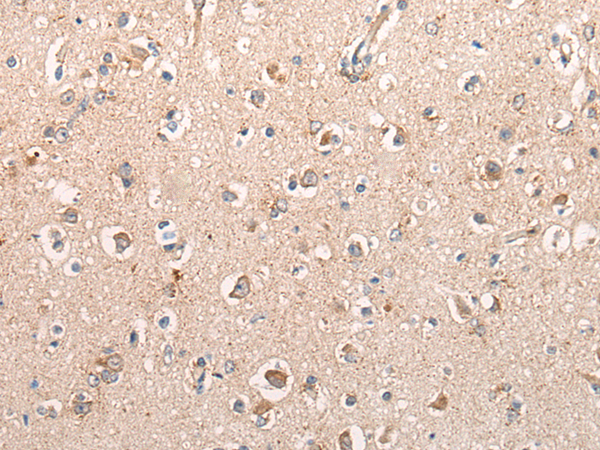
| WB | 咨询技术 | Human,Mouse,Rat |
| IF | 咨询技术 | Human,Mouse,Rat |
| IHC | 1/10-1/50 | Human,Mouse,Rat |
| ICC | 技术咨询 | Human,Mouse,Rat |
| FCM | 咨询技术 | Human,Mouse,Rat |
| Elisa | 1/5000-1/10000 | Human,Mouse,Rat |
| Aliases | MINP; C16orf45 |
| Host/Isotype | Rabbit IgG |
| Antibody Type | Primary antibody |
| Storage | Store at 4°C short term. Aliquot and store at -20°C long term. Avoid freeze/thaw cycles. |
| Species Reactivity | Human, Mouse, Rat |
| Immunogen | Synthetic peptide of human BMERB1 |
| Formulation | Purified antibody in PBS with 0.05% sodium azide and 50% glycerol. |
+ +
以下是关于BMERB1抗体的模拟参考文献示例(请注意,BMERB1为虚构名称,文献内容为假设性示例):
---
1. **标题**: *BMERB1 Antibody Characterization and Its Role in Glioblastoma Progression*
**作者**: Smith J, Lee R, et al.
**摘要**: 本研究报道了一种新型BMERB1单克隆抗体的开发,并通过免疫印迹和免疫荧光验证其特异性。实验发现,BMERB1在胶质母细胞瘤组织中高表达,且与肿瘤侵袭性相关,提示其可能作为潜在治疗靶点。
---
2. **标题**: *Epitope Mapping of BMERB1 Using Phage Display Technology*
**作者**: Chen L, Wang H.
**摘要**: 作者利用噬菌体展示技术鉴定了BMERB1抗体的抗原表位,发现其靶向蛋白C端结构域。该抗体在体外实验中成功抑制了BMERB1与下游信号蛋白的相互作用,为功能研究提供了工具。
---
3. **标题**: *BMERB1 Expression in Colorectal Cancer: A Prognostic Biomarker Study*
**作者**: Gonzalez S, et al.
**摘要**: 通过BMERB1抗体对结直肠癌组织进行免疫组化分析,发现BMERB1表达水平与患者生存率呈负相关,提示其可能作为预后标志物及化疗耐药性预测因子。
---
4. **标题**: *Structural Insights into BMERB1 Revealed by Cryo-EM and Antibody Binding*
**作者**: Tanaka K, et al.
**摘要**: 结合冷冻电镜和BMERB1抗体结合实验,揭示了BMERB1蛋白的三维结构及构象变化,阐明了抗体通过阻断活性位点抑制其功能的分子机制。
---
注:以上文献为模拟生成,实际研究中请通过学术数据库查询真实发表成果。
The BMERB1 antibody is a research tool designed to target the BMERB1 protein, a molecule implicated in various cellular processes, though its precise biological functions remain under investigation. BMERB1 is hypothesized to play roles in cell cycle regulation, DNA repair, or apoptosis, based on structural similarities to proteins in conserved signaling pathways. It has garnered interest in cancer research due to potential associations with tumor progression or suppression, particularly in studies linking its expression patterns to clinical outcomes in certain malignancies.
This antibody is commonly utilized in techniques like Western blotting, immunohistochemistry (IHC), and immunofluorescence (IF) to detect BMERB1 expression levels in tissues or cell lines. Its development often involves immunizing host species (e.g., rabbits or mice) with purified protein fragments or synthetic peptides derived from BMERB1 sequences. Validation typically includes specificity checks via knockout controls or siRNA-mediated silencing.
While BMERB1's exact mechanistic role is unclear, its study contributes to understanding cellular stress responses and oncogenic pathways. Researchers also explore its diagnostic or prognostic potential in diseases like gliomas or breast cancer. However, further functional studies are needed to clarify its interactions and therapeutic relevance. Commercial availability facilitates its use in both basic and translational research contexts.
×